By Dave Duffy
Here’s an interesting fact that most people living in the Pacific Northwest (PNW) are aware of, but only a few dare talk about in specific detail: The PNW is overdue for a gigantic — magnitude 9.0 — earthquake that may kill a quarter million people and dislocate whole cities, including Seattle and Portland, for years.
This is the big one, similar to the magnitude 9.2 Tohoku earthquake and tsunami that destroyed the Northeast coast of Japan in 2011, including the Fukushima nuclear power plant, and similar to the magnitude 9.1 Asia quake in the Indian Ocean in 2004 that killed 280,000 people in 14 countries.
The undersea plate tectonics are similar, with the Juan de Fuca oceanic plate off the PNW coast subducting under the North American continental plate. It’s called the Cascadia Subduction Zone (CSZ). In fact, scientists have modeled the Tohoku quake on the PNW and project that the ground under the PNW, which is compressed over three centuries and artificially high due to the CSZ being locked, will suddenly slide toward the ocean and drop between 3 and 6 feet when the CSZ abruptly unlocks. At the undersea site of the 2011 Japanese quake, the affected tectonic plates slid at least 130 feet and the seafloor rose 30 feet.
The most specific evidence that such a megaquake will occur is kept in a large freezer at Oregon State University (OSU). It consists of dozens of sedimentary cores taken from just off the coast. Sandy layers in the cores from undersea landslides reveal 41 former megaquakes during the last 10,000 years along the CSZ, with the last one occurring 318 years ago. The periodicity of the quakes (average time between them) is 243 years.
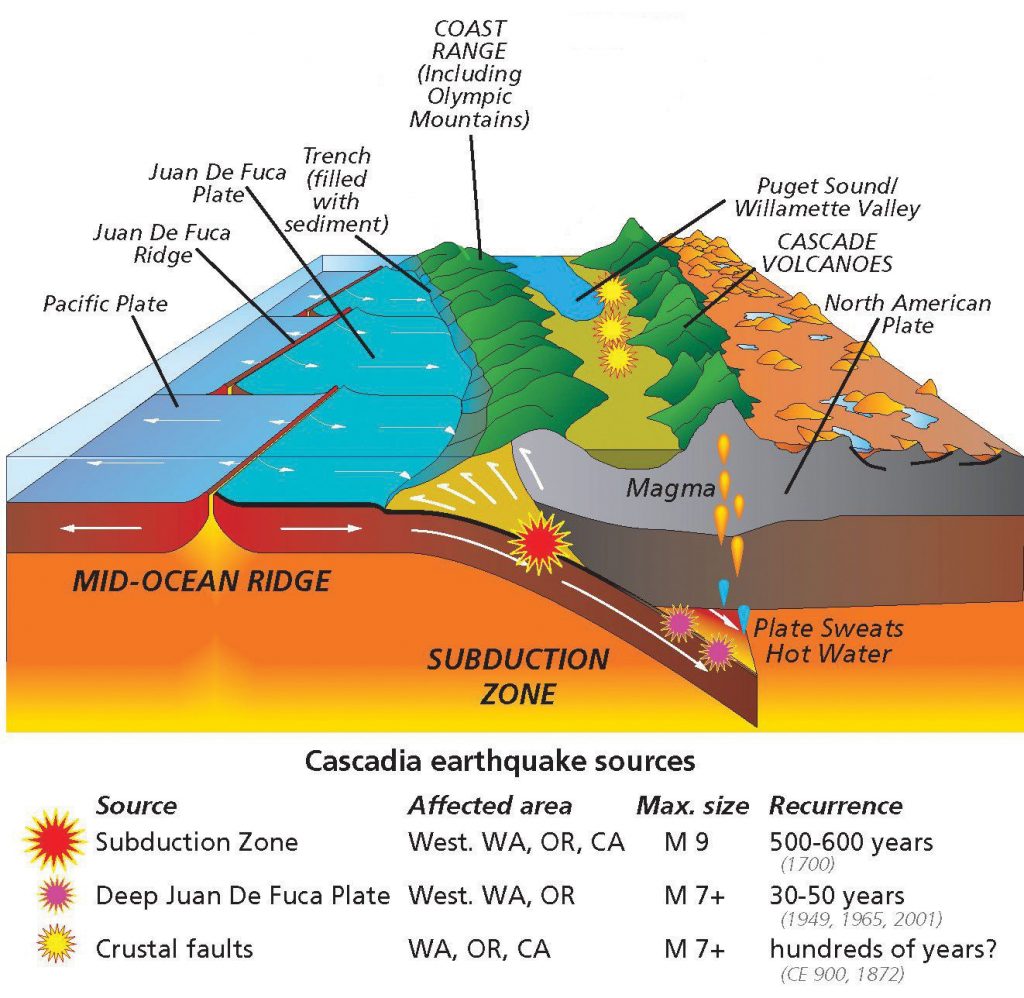 Juan de Fuca plate subducting under the North American plate
Juan de Fuca plate subducting under the North American plate
If you go online, you will discover many documentaries and even college classes that explain the quakes that have happened in the past, what to expect in the future, and the science behind it all. The evidence is overwhelming for what scientists have already dubbed “the greatest natural catastrophe in U.S. history.” If it is indeed the 9.0 earthquake they project, it will be 44 times stronger than the 7.9 quake that destroyed San Francisco in 1906, and a staggering 1,000 times stronger than the typical 7.0 earthquakes that occasionally topple buildings and bridges in California along its famous San Andreas Fault.
Not only will coastal communities be washed away by the triggered tsunami, as we saw in both the Japanese and Asia quakes, but one million buildings are expected to fall from the quake itself, many of them in the PNW’s major cities. Some 15 of the 17 bridges that span Portland’s two rivers will topple, and 15% of the ground underlying Seattle, some of it downtown, will liquify. From Victoria in British Columbia to Redding in California, cities along the Interstate 5 corridor and west to the Pacific Ocean will be devasted, with populations scrambling for food and cast into a world without electricity or water for at least several weeks, possibly months.
The problem is most people in the Pacific Northwest are either not listening, are in denial, or are fatalists who believe there is nothing they can do about it, so few are preparing for this event. This article is intended to help people prepare. It covers the essentials of providing shelter, food, and water, as well as temporary electricity and sanitation until the usual systems of society are restored.
Underlying science
Before we get to the preparedness, let’s quickly look at some of the most salient details of the applicable science and some of the specifics of the expected damage in various areas. You can get far more detail online by watching the numerous YouTube video presentations and college lectures by the very scientists who are studying this upcoming event. They are trying to get the word out so people and municipalities can prepare.
A 9.0 earthquake will release the energy of 16,000 Hiroshima-sized nuclear bombs and be felt 2,000 miles away. The electricity affecting 10 million people will go off within 5 minutes.
Of the 41 previous megaquakes along the CSZ, 19 have been full-fault quakes, ranging from magnitude 8.7 to about a 9.3, and an additional 22 quakes have occurred only on the southern part of the fault, and they have been slightly smaller, although still in the mid 8.0 range. The most recent one, a full-fault rupture of magnitude 9.0 to 9.2 on the Richter Scale, occurred 318 years ago on January 26, 1700, at 9 at night.
Orphan tsunami
We know the time and date of the last earthquake because Japanese scribes recorded what had become known in Japanese history as “the orphan tsunami,” that is, a tsunami without an accompanying earthquake, that came ashore in Japan exactly 10 hours after it occurred in North America in 1700. This was determined in 1996 when Japanese seismologist Kenji Satake converted the dates in an ancient Japanese calendar to our modern calendar and linked the 16-foot Japanese “orphan tsunami” with the year 1700 earthquake that occurred off the PNW coast.
Regarding the periodicity of 243 years, that is an average interval time for 41 quakes over 10,000 years. The actual interval between megaquakes ranges from a few decades to more than 500 years.
The Richter Scale
Earthquakes are measured by the Richter Scale, which shows the comparative energy released. The Richter Scale is logarithmic, in which a difference of one represents an approximate thirtyfold increase in energy released. A magnitude 8 earthquake, for example, releases 31 times more energy than a magnitude 7 earthquake, and a magnitude 9 releases 31 times more energy than a magnitude 8. But a magnitude 9 earthquake releases 1,000 times (roughly 31 times 31) more energy than a magnitude 7. The largest earthquake California’s San Andreas fault is capable of producing is an 8.2, but Subduction Zone earthquakes such as the one off the PNW coast are bigger, often in the range of 8.8 (Chile in 2010) to 9.2 (Japan in 2011).
Native American legends
In the lore of many Native American tribes of the PNW are stories of entire peoples being swept into the ocean at night. According to one tribe’s oral history recounting the fate of Vancouver Island’s Pachena Bay people: “They sank at once, were all drowned. Not one survived.” In 2005, a University of Washington team collected the legends from the tribes and estimated the date of a deadly tsunami on the PNW coast at about 1701.
 The periodicity of earthquakes in the area of the Cascadia Subduction Zone
The periodicity of earthquakes in the area of the Cascadia Subduction Zone
The expected damage
One FEMA expert, Kenneth Murphy, who directs FEMA’s Region X, the division responsible for Oregon, Washington, Idaho, and Alaska said, “Our operating assumption is that everything west of Interstate 5 will be toast.” This is probably an exaggeration as Interstate 5 is a 1 to 3-hour drive from the coast, but there will be lots of destruction up to and beyond the Interstate 5 corridor, with houses having slid off their foundations, electricity interrupted for weeks, and wells not working. The ancient cast iron water piping in older cities like Portland will break, leaving those populations without water.
The closer you are to the CSZ, the more damage there will be. If the quake takes place during the summer, when tourists have flocked to the beaches to escape the inland heat, scientists predict a quarter million people will perish, most by tsunami. The shaking will last anywhere from 4 to 6 minutes, after which residents and tourists will have between 10 and 15 minutes to outrun a tsunami wave. They’ll be escaping over terrain that has been severely broken up by the earthquake. Whoever does make it to the surrounding mountains will endure a wait lasting for at least weeks, as roads and bridges will have been destroyed and resources diverted to the millions displaced in other areas of the state.
If you are further inland, out of reach of the tsunami, and you are not killed by the quake, your odds of survival are good but it will require that you have access to food and water, an alternate source of electricity, and a way to provide shelter if your home is compromised. Scientists estimate there will be no electricity for up to three months, and it will take at least two weeks for highways to be opened so relief efforts can begin.
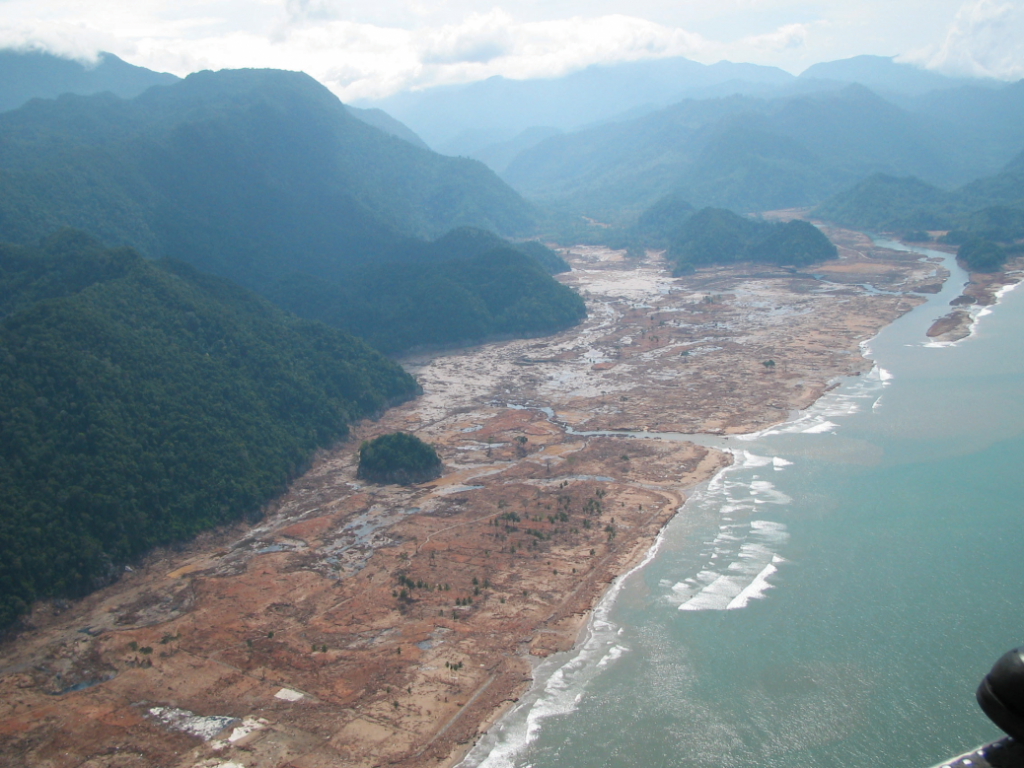 Once a bustling tourist area, the 2004 Asia quake in the Indian Ocean unleashed a tsunami that struck Aceh, Indonesia 15 minutes later, killing more than 170,000 people. (Photo: AusAID)
Once a bustling tourist area, the 2004 Asia quake in the Indian Ocean unleashed a tsunami that struck Aceh, Indonesia 15 minutes later, killing more than 170,000 people. (Photo: AusAID)
If you live in a metropolitan area, such as Portland or Seattle, things will be more complicated. Buildings will have collapsed, bridges will be down, and roads made impassable. All services, including water and electricity, will end abruptly. People used to depending on city conveniences will be instantly cast into a no-man’s land, desperate to find a way to survive. One scientist from Central Washington University, who was loath to make a prediction about human behavior after describing the expected damage in the big cities, said simply, “I wouldn’t want to be there.”
Volcanic eruptions triggered?
There is an additional risk that a megathrust earthquake may trigger an eruption in one of the PNW’s many volcanoes. But Washington state seismologist John Vidale says: “About 10 percent of great earthquakes trigger a volcanic eruption, and most eruptions are fairly minor, so the volcano risk is small compared to the earthquake risk.”
Here are a few predictions for the PNW’s largest cities, Seattle and Portland:
Seattle
About 15% of the soil underlying Seattle, which is the largest city in the Northwest, is expected to liquify. FEMA estimates the quake will trigger 30,000 landslides in and around Seattle. At least one skyscraper is predicted to fall, and many buildings in the 10 to 30-story range could become uninhabitable. A tsunami, however, will not reach Seattle, as it is protected by Puget Sound.
Seattle is vulnerable to severe damage from even a comparitively minor earthquake. A Wikipedia article states: “Other analyses predict that even a magnitude 6.7 earthquake in Seattle would result in 7,700 dead and injured, $33 billion in damages, 39,000 buildings largely or totally destroyed, and 130 simultaneous fires.” This 9.0 megaquake will be more than 2,800 times stronger than a 6.7 earthquake.
Portland
Portland, which includes 60% of Oregon’s population, is 60 miles from the Pacific Ocean. Although only remnants of the tsunami will travel up the Columbia River, it will not do much damage. However, the shaking from the earthquake is predicted to topple 15 of its 17 bridges crossing its two rivers, effectively paralyzing the city.
According to Portland’s write-up in Wikipedia: “Per a 2014 report, over 7,000 locations within the Portland area are at high-risk for landslides and soil liquefaction in the event of a major earthquake, including much of the city’s west side (such as Washington Park) and sections of Clackamas County. . . Portland International Airport sits on the kind of loose fill that will liquefy. FEMA’s primary emergency response airport will default to Redmond, 145 miles away.” (Redmond planners have also been asked to make contingency plans for between 100,000 and 1 million post-quake refugees.)
Also: “Portland’s Bull Run dams are expected to survive, but 60 percent of the city’s water mains are brittle cast iron. Reservoirs will crack and pump stations will fail with a resulting loss of water pressure, both for drinking and for putting out fires. . . Sewers will fail. . . Figure on a year to flush.”
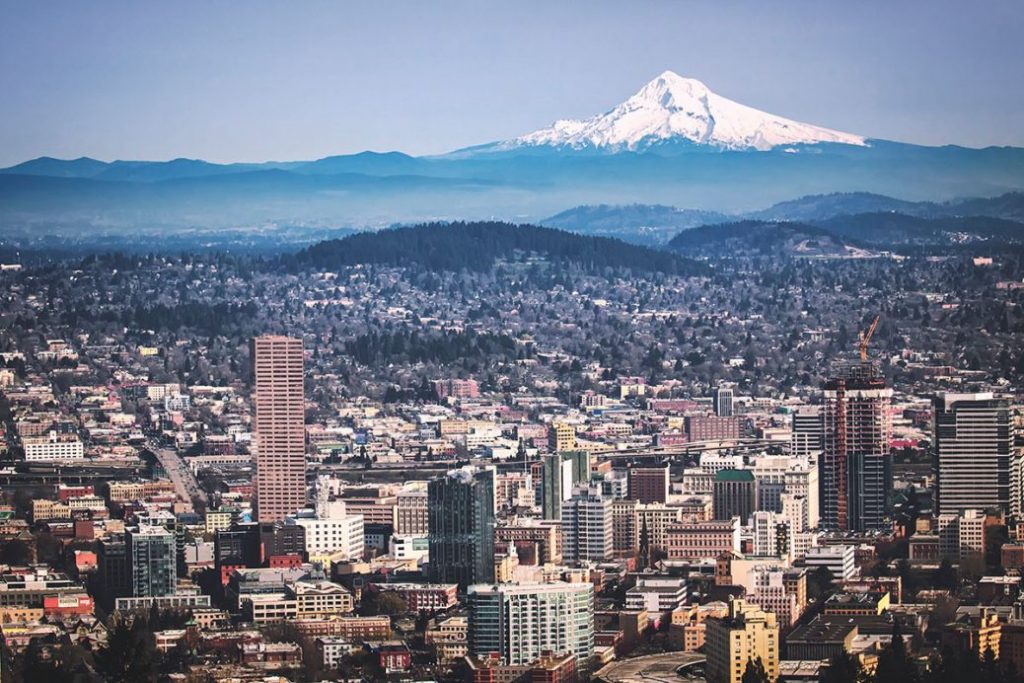 Portland, Oregon, with Mt. Hood in the distance. (Photo by Steven Pavlov.)
Portland, Oregon, with Mt. Hood in the distance. (Photo by Steven Pavlov.)
Portland has about 1,700 unreinforced old brick buildings, and all of them are expected to crumble. Of its estimated 153,000 single-family wooden homes, 78 percent were built before the first seismic codes in 1974, which means they are probably not bolted to their foundations and will likely slide off.
Finally, 95% of Oregon’s fuel is produced by 3 petrochemical plants on the banks of the Willamette River in Portland. They are on fill land that will liquify and collapse the fuel tanks.
Triggers and warnings
If all the dogs in your neighborhood begin to howl simultaneously, that may be the only warning you get that an earthquake is on its way. Their hearing can pick up the nondestructive Primary Seismic Waves travelling at 11,000 mph through the ground. They could last 2 or 3 minutes, and then the destructive Shear Waves, travelling at 6,000 mph, will begin. A full-fault quake on the CSZ is expected to begin on the southern end off the coast of Eureka, California and take between 4 and 6 minutes to reach the top end off Vancouver Island. The shaking, which will be so intense you will not be able to stand, will continue the whole time.
There are GPS stations anchored into bedrock all over the PNW, so scientists have been watching the movement of the tectonic plates. The data does reveal a possible trigger mechanism involving the movement that could give more warning that a megaquake is imminent. It’s complicated and the science is unclear, but you can take a free YouTube class about it online. One excellent lecture about the possible triggers is by Nick Zentner, a geology professor at Central Washington University: www.youtube.com/watch?v=r9recENBhiU.
Preparedness — surviving in place
The rest of this article is about preparedness. Not government assistance with preparedness, but individual preparedness. Government preparedness is definitely in the works. Some of the scientists cited in this article have made their presentations to government in an effort to get funding for early warning systems, and local planners have attempted to beef up their infrastructure and secure funding for their anticipated needs. But the task is enormous, and government also has a poor record of effectively responding to large natural disasters. So you are probably wise to rely largely on yourself.
This will be a “survive in place” disaster since roads will be buckled and undrivable. If you’ve got to go someplace, you’ll either be walking, using a bicycle, or riding a horse. Rather than try and tell you what you’ll need, let me tell you what I keep at my house to safeguard myself and my extended family, which includes four grown children and 3 grandkids living in different houses within a 25-mile radius.
I live in the middle of the Willamette Valley. I have a good chance to survive because I have stored away lots of food and water, have an alternative electricity source, chickens and a garden, and a survival plan. I also live in an area with little chance of civil unrest during a major disaster. My children and grandchildren may have to walk to my house due to impassable roads, but I’ll have ample supplies waiting for them. Your situation could be completely different; maybe you need only prepare for yourself.
For how long must I prepare?
The length of time you must wait out the aftermath of this disaster will depend on where you are. According to The Oregon Seismic Safety Policy Advisory Commission (OSSPAC), the Interstate 5 corridor, which includes cities such as Yreka, Ashland, Medford, Roseburg, Eugene, and Corvallis, will take 1 to 3 months to restore electricity, and 6 to 12 months to restore major highways. On the coast it will be 3 to 6 months to restore electricity and those folks will be without drinking water and sewage systems for 1 to 3 years. Towns in the inundation zone, where the tsunami wave will actually come ashore, may be uninhabitable for months to years.
Food and water
I have about a year’s worth of food and water for 12 people, even though only my wife and I and one college-age son are at home. I have enough for my other two sons and my daughter, her husband, and the three grandkids. Plus I have extra for neighbors who may be unprepared. I have not advertised to the neighbors that I have lots of extra food stored away, but I’m pretty sure I’ll find it difficult to turn away neighbors who are in need.
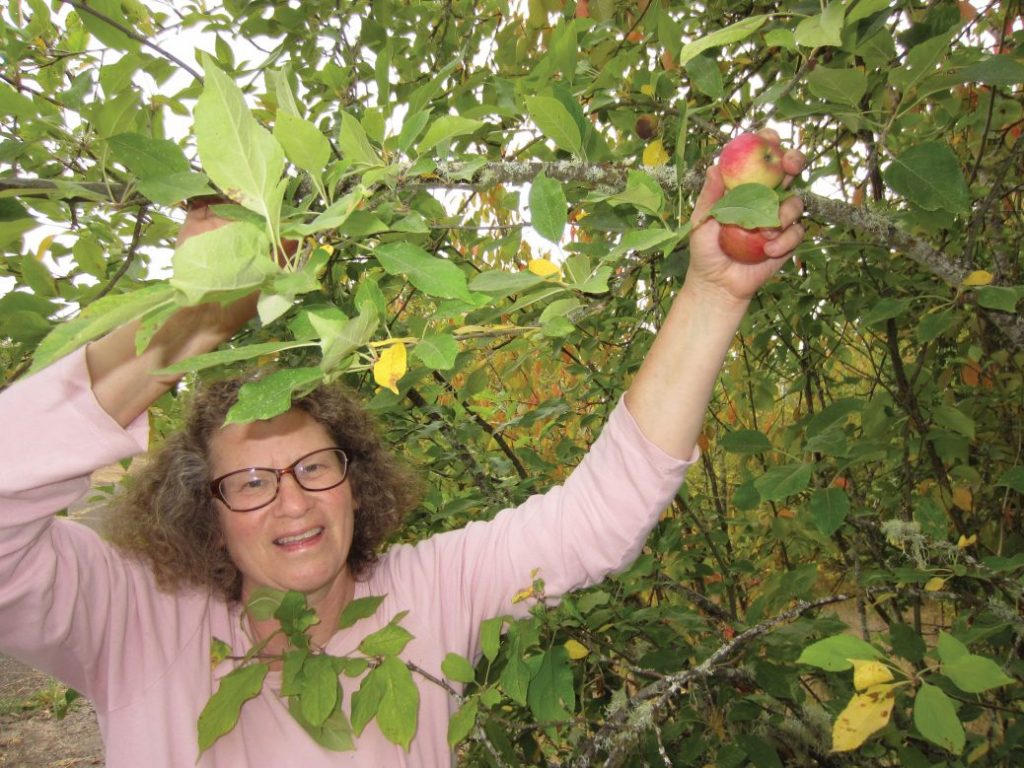 If you live in an agricultural area, gleaning can provide you with a lot of food.
If you live in an agricultural area, gleaning can provide you with a lot of food.
Canned foods and cases of potable water, bought at the supermarket on sale, will go a long way to keeping you fed and hydrated in an emergency. I have a lot of it stored in my pantry and cellar. I’ve hardly noticed the extra expense because I pick up an extra case of this or that when I’m at Costco or Winco. I’ve taken the trouble to date it all so I can use the oldest first. Extra cooking oil and flour will be most welcome in an emergency, as will cans of protein-rich foods like chicken and salmon. Storage dates vary, but unopened olive oil and flour (frozen before it’s stored in the pantry to kill bugs and eggs) will keep for months, and canned foods, either store-bought or ones you have canned yourself, will keep for years. Remember that home-canned glass jars of food could break when falling from shelves, so you will want to rig up some sort of restraining system for both the shelves and jars. We’ll write about such a system in a future article in Self-Reliance magazine.
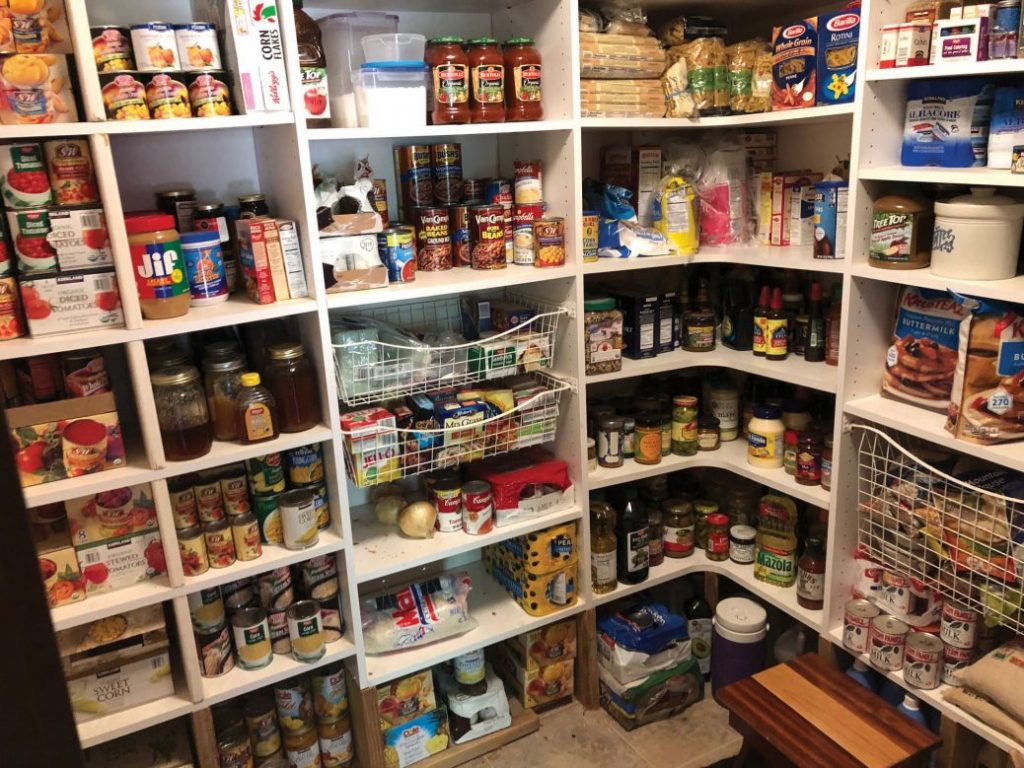 A well-stocked pantry may be essential to help your family survive the aftermath of a megaquake.
A well-stocked pantry may be essential to help your family survive the aftermath of a megaquake.
Potable water is vital. I have a well, and when the electricity goes off I have a generator and have had an electrician rig up my well pump so I can plug it into the generator. I keep a couple of five-gallon cans of fresh non-ethanol gas, treated with Stabil, on hand at all times for the generator. The gas is relatively fresh because I cycle it through my chainsaws, weed eater, blower, mower, etc. (Jeff Yago’s companion article in this issue elaborates on electrical needs and accessing well water during a grid-down event.)
I also have a 1500-gallon supplemental potable water tank, plus I am within hiking distance of the Willamette River and within a walk of a nearby pond. The river and water may not be potable sources, but there are a variety of ways to make water potable. (Patrice Lewis’s companion article in this issue talks more about water.)
We also keep 10 chickens so almost never have to buy eggs at the grocery store, and they will continue to provide us with a good source of protein during a disaster. My wife has kept a garden for years so that will also be handy in an emergency, supplementing our canned food supply with fresh vegetables. And, of course, we store spices and grow herbs to help make our canned foods tasty. (Linda Gabris’s article in this issue on preparing meals from canned goods has more on this topic.)
We also have lots of pasta, bought by the six-pack at Costco, as well as plenty of jars of various spaghetti sauces. And we have cases of soups. Read the nutrition paragraph on a can of something as simple as lentil soup or clam chowder, and you’ll see just how nourishing and filling a good can of soup can be.
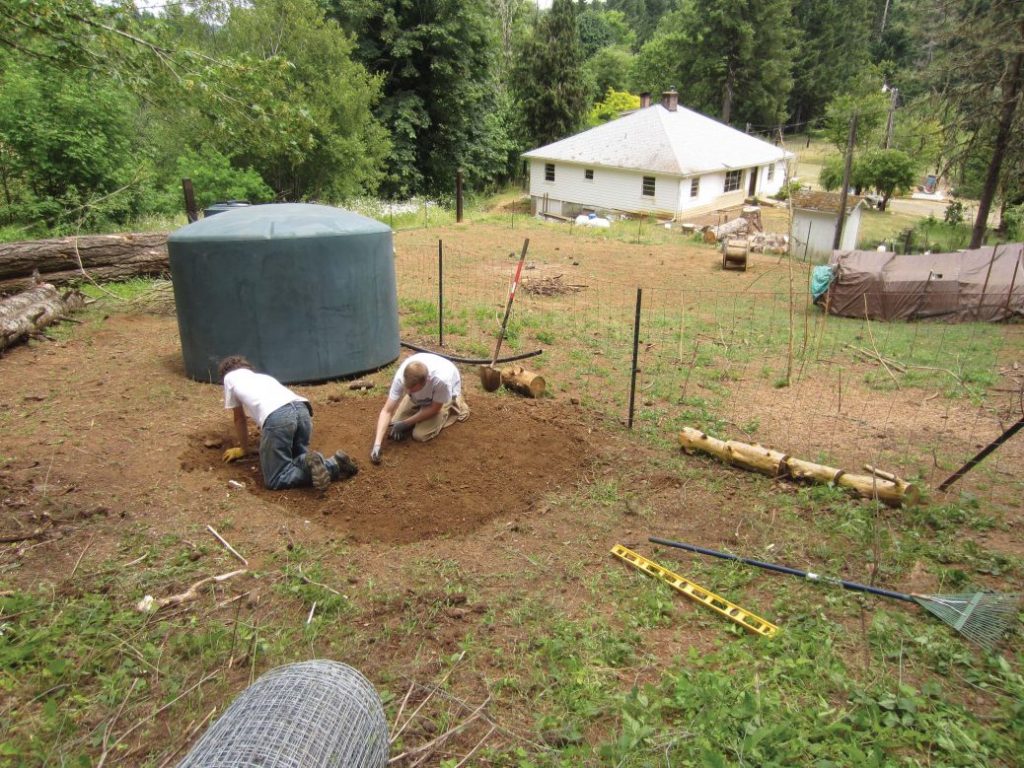 Installing an above-ground water tank is relatively easy, and it has a good chance of surviving a large earthquake.
Installing an above-ground water tank is relatively easy, and it has a good chance of surviving a large earthquake.
I also like my comfort food, and for an Irishman like me that means a few cases of beer stored away. My wife stores plenty of items for baking, and we have a few packages of candy for the grandkids. We’re both coffee people so consider coffee a comfort food. We keep not just fresh beans, but several varieties of unroasted coffee beans, which will keep for 20 years in an unroasted state, and we have a plug-in roaster that will work fine off my generator.
The Willamette Valley is also a lush farming area, and you can’t go very far without running into an unused, untamed fruit tree or berry bush, so there are ample opportunities for gleaning and foraging. Although the rivers have fish and the forests game, expect them to be harvested quickly during an emergency in which everyone is looking for food.
Lights and camping gear
The last megaquake of January 26, 1700 happened at night. If the next one happens at night, in the winter, during a cold Northwest downpour, expect to be uncomfortable and in the dark. At a minimum, you need a good warm raincoat with hood because you’re going to be going outdoors.
We used to camp a lot when our kids were growing up, and we still have our old pop-up camper. What we’ve done is outfit it for an emergency. Even though the next megaquake will be a stay-at-home disaster, we figure that pop-up camper will be our temporary shelter from the elements in our own backyard if our home becomes temporarily uninhabitable. Every member of our family also owns a good sleeping bag with self-inflating mattress, plus a rain-tight tent. We also have camp stoves and propane tanks, a backyard fire pit, and lots of firewood.
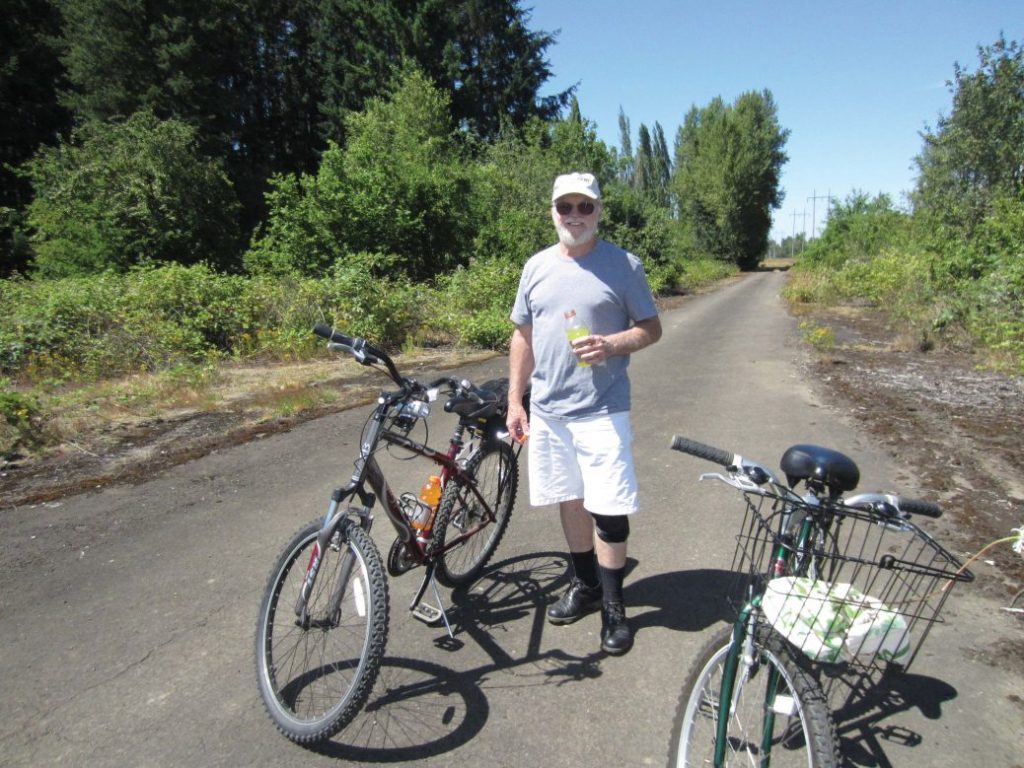 A bicycle or dirt bike may become a prime means of transportation if roads become impassable for cars.
A bicycle or dirt bike may become a prime means of transportation if roads become impassable for cars.
We keep several LED lights, such as lanterns and flashlights, plus regular and rechargeable batteries. I’ve followed many of Jeff Yago’s suggestions in his companion article about lighting in this issue.
Of course I keep lots of toilet paper – about six cases. It’s cheap at Costco. If you’ve read about the progression of the self-induced economic disaster in Venezuela, you know that they’re not just short of food and medicine, but are desperate for toilet paper. If I’m to live through a disaster with a measure of dignity, there are certain things I cannot do without.
Similarly, we buy the industrial boxes of paper towels at Costco by the case. Paper towels help prevent the spread of colds when society works well, and they will certainly help with sanitation if water is scarce.
We also keep extra soap and detergent since there’s a good chance we’re going to get dirty with everything topsy turvy in a disaster.
We have an excellent medical pack that prepares us for just about any emergency. It was purchased from www.doomandbloom.net. And we have a 90-day supply of our prescriptions, having had our doctor convert them from the typical 30-day supply. We also keep extra supplements on hand, such as a bioavailable folate I need, and calcium that my wife needs. (Dr. Joe Alton’s article in this issue has more on medical needs. Joe and Amy Alton’s book, “The Survival Medicine Handbook,” is must reading.)
Since we have grandkids, we have plenty of entertainment at the house, such as CDROMs with all sorts of movies. We also have board games and decks of cards. I expect the internet to be one of the first things that gets up and running during a disaster, so we have a solar-chargeable battery that will run our internet-compatible Samsung TV. That will be handy for both entertainment and disaster news. And, of course, our laptops will work fine on battery power without consuming a lot of power. (Jeff Yago’s article has more on this.)
My wife and I have good walking shoes, plus boots. There’s a good chance we’ll have to do a lot of walking and hiking over rough terrain until society can pull itself back together. For our situation, the plan is for my sons to hike to their sister’s house 15 miles from their apartment and bring her, her husband, and the three grandkids to our house, 25 miles from my daughter but only 10 miles from my sons. A nearby pond is 3/4 of a mile from our house, and the river is about 2½ miles in the opposite direction. Conversely, if our home is untenable, we’ll walk to my daughter’s house. They live on a small river untainted by agricultural runoff so will be fine as potable water.
My house was built in 1973, a year before seismic codes were mandated for most Oregon homes, so I checked to see if the foundation was bolted to the foundation and it was. I breathed a sigh of relief because I did not want to spend the $4,000 it would take to have a contractor bolt it down.
Fire is a specific problem to the Northwest, at least in my area, and I’ve taken precautions against it. I live on three acres, bordered by forests on two sides, so I’ve cut fire breaks to protect my house. I’ve also got fire extinguishers, a plan to shut off the gas line if it breaks, and a plan to fight a fire in my house. If you watch the 2011 Japanese quake videos online, you can see how the fires broke out very quickly from unattended dwellings. That will likely happen in our upcoming megaquake, and those fires have the potential to spread quickly to your own dwelling. So you’ve got to be prepared to fight a fire to protect your home.
We also keep a bit of cold hard cash stashed. In case you don’t have what you need, cash will usually buy it. Most people are, at heart, capitalists willing to make a buck or two. Banks may well be closed for a while, so ready cash will probably be useful. If you think the underground economy is big in America now, just wait until we have a prolonged societal upheaval such as we’ll have after a megaquake.
Just in case, I keep a firearm. I anticipate no problems where I live, but you never know.
Surviving in the city
If you live in a large city, such as Portland or Seattle, surviving the aftermath of a megaquake will be more difficult. You need to designate a contact outside the city where you can either walk to so you can get help, or who you can use as a point of information to coordinate help reaching you. That contact could live in another state and still be of invaluable assistance to guiding your survival efforts. Cell phone service may be out initially, but it should be restored quickly so you can phone them.
You also need to know your evacuation routes out of the city. By now PNW city planners have drawn up hazard maps that list evacuation routes for most neighborhoods. Go down to city hall and get one. They include not just evacuation routes, but hospital locations and other emergency services. When you evacuate, be sure to take with you your driver’s license and other identifying documents, such as a birth certificate or social security card, just in case.
Get a bicycle if you don’t already have one. It may turn out to be a quicker transportation mode out of town. A dirt bike or ATV, along with a few stored gallons of gasoline, may prove invaluable during this emergency. Your car will probably be useless due to the wreckage of the highways.
If you wait for someone from the government to come and help you, you are probably going to wait a very long time, judging from government’s past performance after major hurricanes and floods. This disaster will be much bigger than a major hurricane.
Carmen Merlo, the former director of Portland’s Bureau of Emergency Management, offers a list of things you should do:
- Stay connected. One thing I always have on me is my cellphone. I keep all kinds of emergency information on it—rendezvous points, pre-downloaded maps, emergency response plans, etc. There are many apps for emergency situations. A few of my favorites are: Knots 3D, Zello for walkie-talkie communications, and the Red Cross’ First Aid apps.
- Learn how to urban forage. I took a great class taught by Rebecca Lerner. She has a book called the Dandelion Hunter: Foraging the Urban Wilderness for when food supplies are really scarce.
- Meet your neighbors. In disasters around the world the people most likely to come to your immediate aid are not emergency responders—they’re your friends, families, and neighbors.
- Be a homesteader. I was born in Romania and my parents didn’t have a refrigerator—they had a cave in the back of our house. My parents pickled, canned, and preserved food throughout the summer so we had food in the winter. I keep a basement stocked with dried, pickled, and canned food.
- Think about redundancies. Consider having a back-up power supply, toilet options, food, water, and shelter.
- Ride a bike. Invest in a bicycle (especially a cargo bike) and know how to fix a flat tire. It’ll get you around and help you transport loads.
- Keep comfort items in your emergency kit. There’s some dark chocolate and a bottle of Blanton’s in mine.
- Inspect your home for hazards. Anchor art or other items on your walls, install latches on cabinets and move furniture so that it doesn’t block exit routes. Don’t keep household chemicals somewhere they can spill and accidentally mix, move heavier items to lower shelves, make sure your hot water heater is properly strapped to studs, and check whether your home has been bolted to its foundation.
Final thoughts
In reality, most people will not prepare for a major tragedy like this unless they approach it as a game, a hobby, or can find other rewards for preparing. That’s what my family does. We have water and alternative sources of electricity. My wife and I enjoy our large garden and 10 chickens, which provide us with fresher vegetables and healthier eggs than we can buy at the store. They will be invaluable assets when dealing with the aftermath of a megaquake.
The scientists tell us it’s a matter of when, not if, it will happen . . . our lifetime, our kids, our grandkids? No one knows for sure, but I plan to be as prepared as I can be.

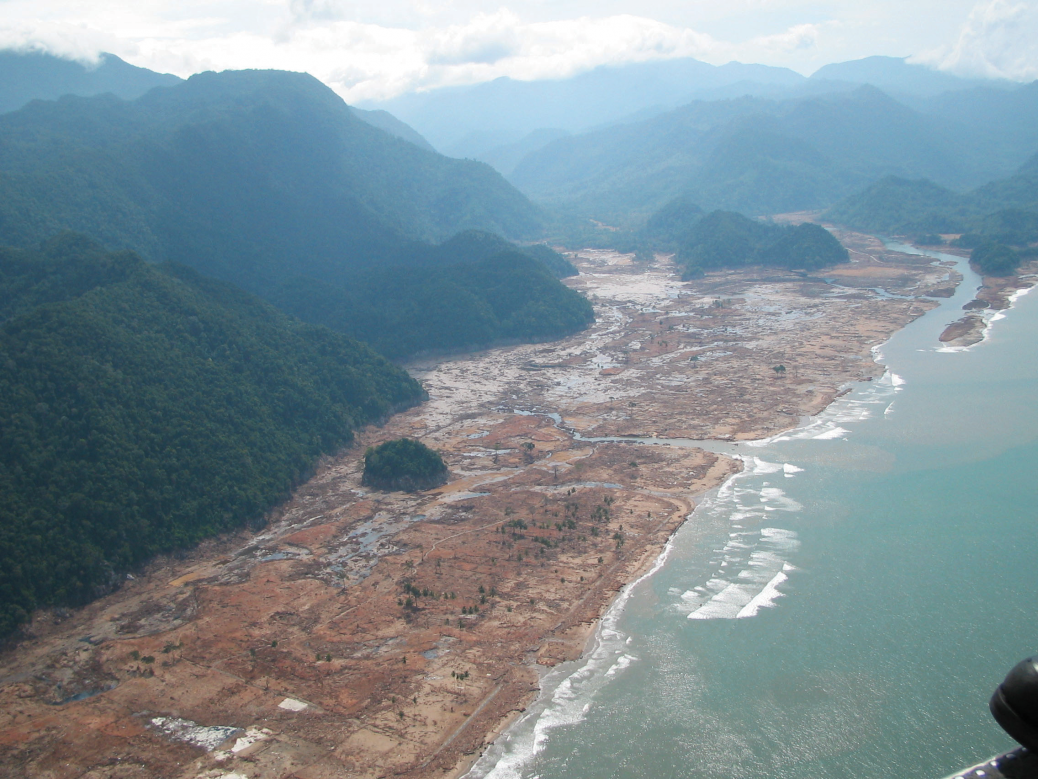
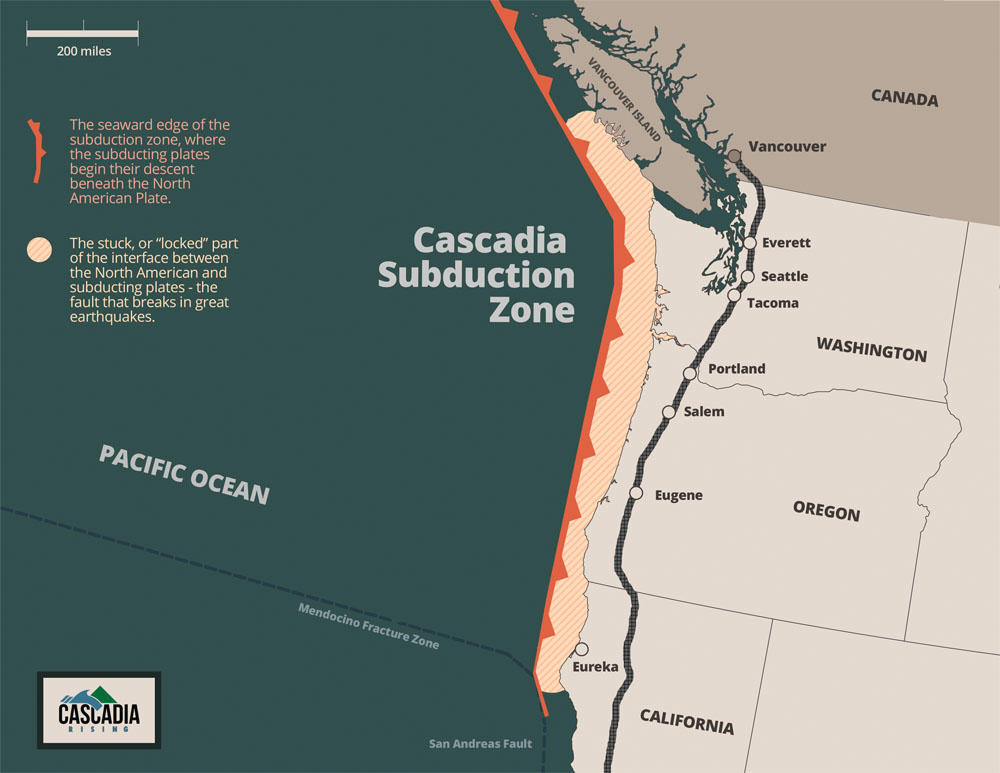
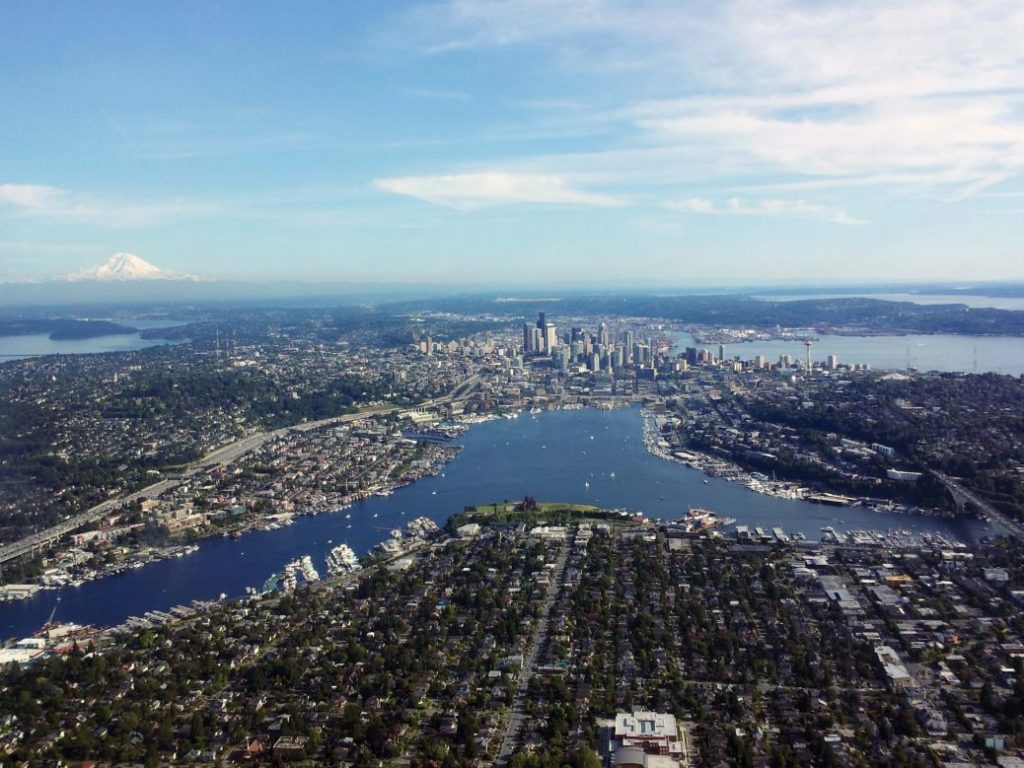
Kinda like going back to the pump on the porch and a woodshed to keep the cookstove going that we had when I was a kid.
Love seeing self sustaining info. As a fan of Mother Earth news since the 70’s. More info great. Like the head for the hills in the 70’s, 50 years latter I am seeing the same urge,, need for returning to our roots. Refreshing, Thank You
Excellent! Thanks.